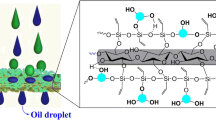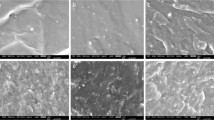Abstract
Applying a low surface energy water-repellent finish agents to fabric is one of the effective ways to make it obtain water-repellent function. Water-repellent finish agents are mainly divided into two categories, fluorinated and non-fluorinated, and fluorinated water-repellent agents will be gradually banned because of environmental protection issues. Organosilicons, polyacrylates, and dendritic macromolecules are the most studied types of non-fluorinated water-repellent agents, but there are some problems in the preparation and use of these non-fluorinated water-repellent agents. Here, using 58 # fully refined paraffin wax as raw material, the paraffin wax was modified by no catalytic oxidation modification method to improve its emulsification performance. The oxidation-modified paraffin wax was used as raw material to prepare a stable, uniform and good fluidity water-repellent emulsion. The oxidation-modified paraffin wax emulsion was used as a water-repellent agent, and waterborne polyurethane (WPU) was used as a crosslinking agent to finish pure cotton fabrics and polyester/cotton-blended fabrics. After water-repellent finish, the contact angle of pure cotton fabric was 135° and that of polyester/cotton-blended fabric was 145°. This study provides a useful way for exploring non-fluorinated water-repellent agent with low cost and simple production process.












Similar content being viewed by others
Data Availability
All data included in this study are available upon request by contact with the corresponding author.
References
C. Zhang, Donghua University (2015)
J. Huang, G. Lin, T. Wang, W. Song, Dyeing Finishing 32(010), 34–36 (2006). https://doi.org/10.3321/j.issn:1000-4017.2006.10.011
W. Wang, Suzhou University (2016).https://doi.org/10.7666/d.D01004740
S. Ruidas, A. Das, S. Kumar, S. Dalapati, U. Manna, A. Bhaumik, Angew. Chem. Int. Ed. Chem. Int. Ed. 61, e202210507 (2022). https://doi.org/10.1002/ange.202210507
A. Bashari, A.H.S. Koohestani, N. Salamatipour, Fibers Polym. 21(2), 317–323 (2020). https://doi.org/10.1007/s12221-020-9568-6
T. Li, Y. Qian, Y. Sun, F. Yang, J. Wei, Guangdong Chem. Indus. 45(14), 268–269272 (2018). https://doi.org/10.3969/j.issn.1007-1865.2018.14.129
Z. Zhao, L. Zhang, Y. Li, J. Du, C. Xu, Dyeing Finishing 48(12), 1–5 (2022)
Q. Gao, Q. Zhu, Y. Guo, Ind. Eng. Chem. Res. 48(22), 9797–9803 (2009). https://doi.org/10.1021/ie9005518
Y. Xu, Z. Sui, W. Zhao, Q. Zhang, Dyeing Finishing 49(2), 12–16 (2023)
H. Yi, Oil Gas Field Surf. Eng. 25(6), 58–59 (2006). https://doi.org/10.3969/j.issn.1006-6896.2006.06.049
Z. Cao, B. Hou, W. Chen, H. Wang, Chem. Prod. Technol. 12(1), 4 (2005). https://doi.org/10.3969/j.issn.1006-6829.2005.01.009
Z. Chen, S. Zhao, B. Huang, Z. Lu, Mod. Textile Technol. 22(006), 18–21 (2014)
Y. Qu, X. Luo, Chem. Ind. Eng. Progr. 36(6), 2137–2142 (2017). https://doi.org/10.16085/j.issn.1000-6613.2017.06.024
Y. Wu, X. Yang, Chem. Manag. 12, 1 (2017). https://doi.org/10.3969/j.issn.1008-4800.2017.12.107
N. Duan, W. Chen, Y. Hu, Appl. Chem. Ind. 39(8), 1152–1154 (2010). https://doi.org/10.3969/j.issn.1671-3206.2010.08.012
X. Fu, L. Zhu, L. Zhu, J. Southwest Petrol. Univ. 35(2), 6 (2013). https://doi.org/10.3863/j.issn.1674-5086.2013.02.024
X. Li, K. Liao, Y. Cong, Shanxi Chem. Ind. 25(2), 38–42 (2005). https://doi.org/10.3969/j.issn.1004-7050.2005.02.011
L. Wang, H. Guo, G. Chen, X. Wu, L. Tang, Mod. Food Sci. Technol. 23(6), 81–83 (2007). https://doi.org/10.3969/j.issn.1673-9078.2007.06.025
Z. Sun, Y. Zhuang, H. Yang, H. Ge, Q. Luo, J. Build. Mater. 26(4), 397–402 (2023). https://doi.org/10.3969/j.issn.1007-9629.2023.04.009
F. Zhao, Beijing Univ. Chem. Technol. (2002). https://doi.org/10.7666/d.Y429428
Z. Guo, H. Li, J. Shen, H. Zhao, Pet. Process. Petrochem. Petrochem. 07, 47–50 (2009). https://doi.org/10.3969/j.issn.1005-2399.2009.07.012
Q. Yi, M. Liu, B. Hou, M. Erni, R. Liu, J. For. Eng. 6(2), 101–107 (2021)
B. Shen, Y. Feng, J. Gao, Pet. Process. Petrochem.Petrochem. 32(11), 52–55 (2001). https://doi.org/10.3969/j.issn.1005-2399.2001.11.013
Acknowledgements
The authors thank State Key Laboratory of New Textile Materials and Advanced Processing Technologies of Wuhan Textile University for instrumental facility to conduct the performances analysis. The authors are also thankful to Ningbo Zhongtian Apex Household Commodities Company Limited and Wuhan Yudahua Textile and Garment Group Company Limited for providing some experimental materials.
Author information
Authors and Affiliations
Corresponding author
Ethics declarations
Conflict of Interest
The authors declared that they have no conflicts of interest to this work and they do not have any commercial or associative interest that represents a conflict of interest in connection with the work submitted. The authors declare that they have no any actual or potential conflict of interest including any financial, personal or other relationships with other people or organizations.
Rights and permissions
Springer Nature or its licensor (e.g. a society or other partner) holds exclusive rights to this article under a publishing agreement with the author(s) or other rightsholder(s); author self-archiving of the accepted manuscript version of this article is solely governed by the terms of such publishing agreement and applicable law.
About this article
Cite this article
Tan, Q., Zhou, M., Chen, Z. et al. Oxidation Modification of Paraffin Wax and Preparation of Water-Repellent Finish Emulsion. Fibers Polym (2024). https://doi.org/10.1007/s12221-024-00567-8
Received:
Revised:
Accepted:
Published:
DOI: https://doi.org/10.1007/s12221-024-00567-8




